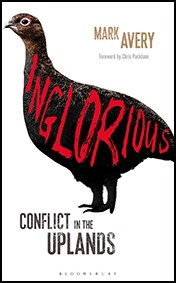Inglorious by Mark Avery

The book is written by Dr Mark Avery, former Conservation Director at the RSPB and a key figure in the battle of the uplands, a civil war that's threatening to turn more and more uncivil as the weeks leading up to the 12th pass. It is — if you're on one side — everything you hoped it might be: entertaining, surgical, accessible, and utterly, ruthlessly logical. If you're on the other, howver, it's everything you hoped it wouldn't be.
It kicks off with an excoriating foreword by Chris Packham, who takes a verbal flame-thrower to the "tiny, selfish, destructive minority who measure their pleasure in the number of things they can kill". Inglorious details the story of the Hen Harrier in Britain and its persecution by game interests, then takes us through the history of grouse shooting, and on to the important study of Hen Harriers and grouse bags at Langholm Moor. Mark next looks at the period from the end of the first Langholm study to the end of 2013 — years during which it became clearer that intensive grouse moor management wasn't in the public interest for reasons unconnected with Hen Harriers or birds of prey.
Chapter 5 celebrates what might be called the 'Year of the Hen Harrier', during which the Hen Harrier conservation movement spread out from established NGOs and organisations to birders and the general public. This is followed by an imaginary scenario where a former gamekeeper turned wildlife guide looks back on the bad old years of persecution and demonisation of Hen Harriers. Inglorious wraps up with a short chapter on how to bring an end to driven grouse shooting, should the arguments presented in the book have persuaded you that there is, after all, nothing glorious about raising vast numbers of birds to be blasted apart over precious habitat that increasingly resembles intensively managed farmland.
A battle plan, a manual and a thorough investigation, Inglorious clearly and calmly explains what drew Mark to this particular fight (he isn't against shooting per se, incidentally), and how he reached his conclusions that driven grouse shooting is bad for the land, bad for the taxpayer, bad for the environment, and of course, bad for our birds of prey. It is well written, the language used easy going and delivered with a metaphoric twinkle in the eye that says: "Hey, this is only my opinion," while daring the reader to come up with a valid riposte.
That's some challenge, though, because more than anything Inglorious is intelligent and convincing, the arguments honed via by decades on the frontline, a lengthy series of blog posts and readers' comments, and an unquenchable curiosity to keep on learning.
The book is honest, too. Mark acknowledges that predation by foxes hits Hen Harriers; that Hen Harriers do eat Red Grouse chicks, although not enough to impact their overall populations, but sufficient to deny 'sportsmen' what they chillingly call the 'shootable surplus'; and that some moorland-breeding shorebird species do well on land managed by gamekeepers. As far as the first two points go, that's what's called 'nature'. Should we trade the burning of peat (one of the most effective carbon-storing ecosystems on the planet), the permanent disfigurement of SSSIs and SACs with roads and shooting butts, the piles of dead Mountain Hares and Stoats, the tons of lead shot polluting soil and water, and the illegal persecution of birds of prey for a few more Eurasian Curlews and European Golden Plovers? If that's the best argument for continuing with driven grouse shooting in its current destructive form then, as Inglorious makes clear, it's a very feeble one.
Is this book the 'death by a thousand cuts' the driven grouse industry should fear? It is a surgical dissection by a writer at the top of his game, but it's not entirely immune from criticism. There is a joke that jars and should perhaps have been edited out, and some right-of-centre commentators will undoubtedly denounce it as an attack on 'class privilege' from a Labour-supporting bolshie. But it will be very, very hard to cogently defeat the arguments laid out in Inglorious. And as Mark himself said in a recent interview, simply "calling Mark Avery a prat" really isn't going to be a counter-argument of any value whatsoever.
Mark Avery is someone you'd much prefer on your side than against you, and Inglorious is a remarkable book. Established 'sporting' practices have rarely been challenged like this or come under such clear-eyed scrutiny — and even more rarely in a book aimed squarely at the everyday birder and general public rather than specialists. Anyone with the slightest interest in why we're missing so many Hen Harriers from upland moorlands and why we're increasingly hearing concerns about the state of some of our most beautiful countryside, really should read this book. If your interest extends into involvement and activism, you will find Inglorious empowering. If your interest in Red Grouse is purely financial, you've clearly hacked Mark Avery off, and frankly you've only yourself to blame for the consequences.
Inglorious is available for purchase at a discount of up to £3 off the suggested retail price from the Birdwatch bookshop.



